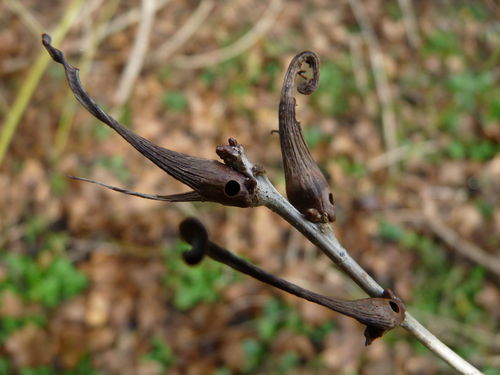Ram’s-horn gall Andricus aries at Whitethorn Bank, Rushwick, Worcester
Graham Hill and Ann Hill
In the autumn of 2012, as part of the Woodland Trust’s celebration of Queen Elizabeth II Diamond Jubilee, we planted an English Oak Quercus robur at our small woodland nature reserve near Rushwick. The one year-old whip had been grown from acorns collected from the renowned collection of oak trees in Windsor Great Park, so it came with royal heritage – of some sort!
The woodland already supports a collection of trees which are recorded on the Worcestershire Ancient Trees Database, most are boundary trees in excess of 150 years of age, with one pollard oak probably 250–300 years old. We hope that, a long time after we have gone this Windsor Oak will follow the lead of the others.
Just before Christmas 2014 we were in the woodland, and took a look at the Windsor oak to see how it was getting along. It had put on some growth through the intervening two years, although the leader looked unusual, different in some way. On closer inspection we realised that the leader buds had been parasitized by a gall wasp. The galls were brown with a round base and one or two points, around 2cm long, on the upper side – looking like miniature jesters’ hats. Each gall had a small exit hole towards in the base (01).
The gall of the Andricus aries was first recorded in Berkshire in 1997, and has since spread across the southern half of England (Chinery, 2011). Two generations are possible each year from the same host, the gall develops on a bud in the summer, initially it is green but turns brown as it ages, and the gall wasp emerges either in the following autumn or spring. The gall can remain on the bud for several years. Although all three buds on the leader of our Windsor Oak were parasitised, new buds are developing alongside, so we hope that the tree will survive.
This is the third record for Worcestershire, and fits neatly into the middle part of Worcestershire between records of the Ramshorn Gall at Hollybed Farm near Castlemoreton and Blakeshall in North Worcestershire from 2013 (Simpson and Westwood, 2013). Given that the sapling had been ‘imported’ from Berkshire, it is possible that the gall wasp arrived with the plant, although this is not certain.
References.
Chinery, M. 2011. Britain’s Plant Galls. The British Plant Gall Society.
Simpson, A. & Westwood, B. 2013. Ram’s-horn Gall Andricus aries found in Worcestershire. Worcestershire Record 35:45.
Images
01. Ram's-horn Gall Andricus aries on oak near Worcester. Graham Hill
